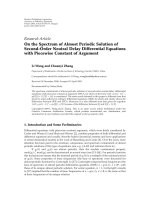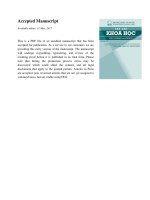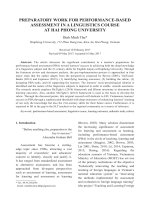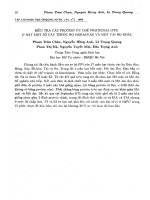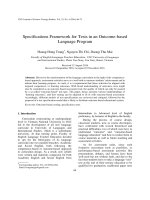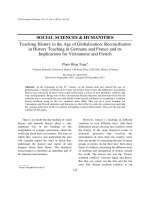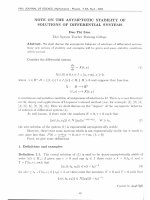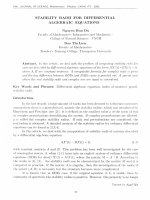DSpace at VNU: Massera criterion for periodic solutions of differential equations with piecewise constant argument
Bạn đang xem bản rút gọn của tài liệu. Xem và tải ngay bản đầy đủ của tài liệu tại đây (122.39 KB, 13 trang )
J. Math. Anal. Appl. 302 (2005) 256–268
www.elsevier.com/locate/jmaa
Massera criterion for periodic solutions
of differential equations with piecewise
constant argument
N.T. Thanh
Department of Mathematics, Hanoi University of Science, 334 Nguyen Trai, Hanoi, Viet Nam
Received 2 October 2002
Submitted by Z.S. Athanassov
Abstract
In this paper, we prove the almost periodicity of bounded solutions and a so-called Massera criterion for the existence of periodic solutions to differential equation with piecewise constant argument.
2003 Published by Elsevier Inc.
1. Introduction
In this paper, we are concerned with differential equations with piecewise constant argument of the form
x˙ = Ax [t] + f [t] ,
x(t) ∈ Cn ,
(1.1)
where A is a linear operator on Cn , f is a bounded continuous function from R to Cn , [·] is
the largest integer function. Differential equations with piecewise constant argument have
been considered in many works since they are found appropriate to various applications
(see, for example, [18,19,21] and the references therein).
The main purpose of this paper is show a spectral condition for almost periodicity of
bounded solutions and the existence of periodic solutions to Eq. (1.1) via the so-called
Massera criterion. Massera criterion [12] was first introduced by Massera in 1950 to ordinary differential equations, saying that the linear differential equation of the form
E-mail address:
0022-247X/$ – see front matter 2003 Published by Elsevier Inc.
doi:10.1016/S0022-247X(03)00407-4
N.T. Thanh / J. Math. Anal. Appl. 302 (2005) 256–268
257
x˙ = A(t)x(t) + f (t),
where A, f is continuous, periodic with the same period τ , has a periodic solution with
period τ if and only if it has a bounded solution on R+ . Subsequently, it has been extended
to ordinary functional differential equations (OFDE) of delay type in [2], to OFDE with
advance and delay in [4,10,11], to abstract functional differential equations in [20]. Recently, it has been extended to almost periodic solutions of evolution equations in [13–16].
For a more complete introduction to this topic we refer the reader to any introduction of
these papers and counterexamples for almost periodic equations in [6,7].
However, as will be shown in this paper, in general Massera criterion does not hold true
for Eq. (1.1). For instance, if f is periodic with irrational period, then Eq. (1.1) has no
periodic solutions. If in addition, the period of f is assumed to be rational, we can show
that Massera criterion for (1.1) holds true.
The main technique of this paper is to use the notion of spectrum of a function which
has been widespreadly employed in recent researches such as [3,15–17]. We will estimate
the spectrum of a bounded function, and based on the obtained estimates we will consider
the almost periodicity or periodicity of solutions. The main results of the paper are Theorems 3.2, 3.5, and 3.9. An estimate of the spectrum of a bounded solution to Eq. (1.1) is
obtained in Theorem 3.2. Theorem 3.5 gives a spectral condition for almost periodicity of
bounded solutions to Eq. (1.1). Based on [14], Theorem 3.9 shows the existence of periodic
solutions to Eq. (1.1).
2. Preliminaries
In this section we recall the notion of a spectrum of a bounded function and some
important properties. For more details we refer the reader to [8,17].
2.1. Notations
Throughout the paper we will use the following notations: Z, R, C stand for the sets
of integers, real, and complex numbers, respectively. X denotes a given complex Banach
space. If A is a linear operator, then the notations σ (A), ρ(A), and R(λ, A) stand for the
spectrum, resolvent set, and resolvent of the operator A. We also denote the spectrum of
a function f by sp(f ). The notation L1loc (R, X) means the Banach space of measurable,
local integrable functions from R to X. In this space, the subspace BM(R, X) consists of
t +1
f ∈ L1loc (R, X) such that supt ∈R t
f (s) ds < +∞. As usual, BC(R, X), BUC(R, X),
AP(R, X) stand for the spaces of all X-valued bounded continuous and bounded uniformly
continuous functions on R and their subspace of almost periodic functions, respectively.
2.2. The spectrum of a bounded function
In this paper, we will use the notion of Carlemann spectrum of a function u ∈ BM(R, X),
denoted by sp(u), consisting of all real numbers ξ such that the Fourier–Carlemann transform of u
258
N.T. Thanh / J. Math. Anal. Appl. 302 (2005) 256–268
u(λ)
ˆ
:=
∞ −λt
u(t) dt
0 e
∞ λt
− 0 e u(−t) dt
if Re λ > 0,
if Re λ < 0
has no holomorphic extension to any neighborhood of iξ (see, e.g., [8,17]). Some basic
properties of the Fourier–Carlemann transform and the spectrum of a function and their
relation to the behavior of the function are listed below for the reader’s convenience. We
refer the readers to [9,17] for the proof.
Proposition 2.1. Let u, v ∈ BM(R, X) and α, β ∈ C. Then the following statements hold
true:
(i) (αu + βv)(λ) = α u(λ)
ˆ
+ β v(λ).
ˆ
(ii) If there exists u˙ ∈ BM(R, X) then
u(λ)
˙ˆ
= λu(λ)
ˆ
− u(0).
(iii) Let A be a continuous linear operator from X to X. Put (Au)(t) := Au(t), ∀t ∈ R
then
Au(λ) = Au(λ).
ˆ
Proposition 2.2 [17, p. 20]. Let u, v ∈ BM(R, X), α ∈ C \ {0}. Then the following statements hold true:
(i)
(ii)
(iii)
(iv)
(v)
(vi)
(vii)
sp(u) is closed.
sp(u(· + h)) = sp(u).
sp(αu) = sp(u).
sp(u + v) ⊂ sp(u) ∪ sp(v).
sp(u)
˙ ⊂ sp(u) if u˙ ∈ BM(R, X).
If A is a continuous linear operator from X to X then sp(Au) ⊂ sp(u).
¯
If un ∈ BUC(R, X), un converge to u uniformly and sp(un ) ∈ Λ, then sp(u) ⊂ Λ.
2.3. Almost periodic and periodic functions
There are close relations between spectra of functions and their behaviors at infinity. In
fact, we have
Proposition 2.3 (see, e.g., [5, p. 29]). Let f ∈ BUC(R, X). Then f is periodic with period τ
if and only if sp(f ) ⊂ 2πZ/τ .
Recall that a subset E ⊂ R is said to be relatively dense if there exists a number l > 0
(inclusion length) such that every interval [a, a + l] contains at least one point of E. Let
f be a continuous function from R to X. Recall also that f is said to be almost periodic
(in the sense of Bohr) if for every ε > 0 there exists a relatively dense set T (ε, f ) such
that
sup f (t + τ ) − f (t)
t ∈R
ε,
∀τ ∈ T (ε, f ).
N.T. Thanh / J. Math. Anal. Appl. 302 (2005) 256–268
259
Proposition 2.4. Let u ∈ BUC(R, X). Then the following statements holds true:
(i) If sp(u) is countable and X does not contain any subspace isomorphic to the space of
sequences c0 , then u is almost periodic.
(ii) If sp(f ) is discrete then u is almost periodic.
We refer the readers to [9, Theorem 4, p. 92] for the proof of (i), and [1, Theorem 4.8.7,
p. 322] for (ii).
Remark 2.5. If dim X < ∞, then it never contains any subspaces isomorphic to c0 . So, this
condition is automatically fulfilled in the finite-dimensional case.
3. Almost periodic and periodic solutions
In this section, we will deal with almost periodicity of bounded solutions and the existence of periodic solutions to Eq. (1.1). First, we make precise the notion of solutions to
Eq. (1.1).
Definition 3.1. A function x(·) : R → Cn is said to be a solution of Eq. (1.1) if it is continuous on R, differentiable on R except at most of integers and satisfies Eq. (1.1) on every
interval [n, n + 1), n ∈ Z, where at t = n the derivative of x is the right one.
3.1. The spectrum of a bounded solution
For a matrix A we denote σei (A) = {ξ ∈ R: eiξ − 1 ∈ σ (A)}. The notation f¯ stands for
the function, defined by the formula
f¯(t) = [t] , ∀t ∈ R.
Theorem 3.2. Let x(·) is a bounded solution of Eq. (1.1). Then the following estimates
hold true:
sp(f¯) ⊂ sp(x) ∪ 2πZ,
sp(x) ⊂ σei (A) ∪ sp(f¯).
(3.1)
(3.2)
Proof. We first consider the case of Re λ > 0. By taking the Fourier–Carlemann transforms
of functions and by Proposition 2.1, we have
x(λ)
˙ˆ
= λx(λ)
ˆ
− x(0).
(3.3)
Since x(·) is a solution to Eq. (1.1),
x(λ)
˙ˆ
= Ax [·] (λ) + fˆ¯(λ) =
e
0
e−λt Ax [t] + f¯(t) dt
0
+∞
+∞
=
+∞
−λt
Ax [t] dt +
e
0
+∞
−λt
e−λt x [t] dt + fˆ¯(λ).
f¯(t) dt = A
0
(3.4)
260
N.T. Thanh / J. Math. Anal. Appl. 302 (2005) 256–268
Set
+∞
g(λ) =
e
−λt
∞ k+1
k=0 k
0
∞
e−λt x(k) dt =
x [t] dt =
k=0
1 − e−λ −λk
e x(k).
λ
We have
∞
e−λk x(k) =
k=0
λ
g(λ).
1 − e−λ
(3.5)
On all intervals (n, n + 1), n ∈ Z we have x(t)
˙ = Ax(n) + f (n), so x(t) is linear on
(n, n + 1), i.e.,
x(t) = x [t + 1] − x [t]
t − [t] + x [t] .
Hence,
+∞
x(λ)
ˆ
=
+∞
e
−λt
e−λt x [t + 1] − x [t]
x(t) dt =
0
t − [t] + x [t]
dt
0
+∞
=
+∞
e
−λt
x [t + 1] − x [t]
e−λt x [t] dt
t − [t] dt +
0
0
∞ k+1
e−λt x(k + 1) − x(k) (t − k) dt + g(λ)
=
k=0 k
k+1
∞
e−λt (t − k) dt + g(λ)
x(k + 1) − x(k)
=
k=0
k
k+1
∞
=
1
− e−λt (t − k)
λ
x(k + 1) − x(k)
k=0
1 − e−λ
x(k + 1) − x(k)
=
1 − e−λ − λe−λ
λ2
1 − e−λ
− λe−λ
λ2
From (3.5) and (3.6) we have
− λe−λ
λ2
k=0
=
k
1
+
λ
e−λt dt + g(λ)
k
∞
=
k+1
∞
e−λk + g(λ)
e−λk x(k + 1) −
k=0
∞
λ
e
k=0
∞
e−λk x(k) + g(λ)
k=0
e−λ(k+1)x(k + 1) −
∞
k=0
e−λk x(k) + g(λ).
(3.6)
N.T. Thanh / J. Math. Anal. Appl. 302 (2005) 256–268
x(λ)
ˆ
=
=
=
1 − e−λ − λe−λ
λ2
eλ
261
λ
λ
g(λ) − x(0) −
g(λ) + g(λ)
1 − e−λ
1 − e−λ
1 + λ − eλ
1 − e−λ − λe−λ
+
1
g(λ)
+
x(0)
λe−λ
λ2
λ + 1 − eλ
eλ − 1
g(λ) +
x(0).
λ
λ2
Thus
g(λ) =
eλ
λ
λ + 1 − eλ
x(0) .
x(λ)
ˆ
−
−1
λ2
(3.7)
From (3.3), (3.4), and (3.7) we have
λx(λ)
ˆ
− x(0) = A
λ + 1 − eλ
λ
x(λ)
ˆ
−
x(0) + fˆ¯(λ).
eλ − 1
λ2
Therefore,
eλ − 1 ˆ¯
eλ − λ − 1
eλ − 1
x(0)
+
Ax(0)
+
f (λ).
λ2
λ
λ
In the case of Re λ < 0, by computing as above, we get the same result. So, in all cases the
following estimate holds true:
ˆ
=
eλ − 1 − A x(λ)
ˆ
= ρ(λ) +
eλ − 1 − A x(λ)
eλ − 1 ˆ¯
f (λ),
λ
(3.8)
where
ρ(λ) =
eλ − 1
eλ − λ − 1
x(0).
Ax(0)
+
λ2
λ
Since
eλ − λ − 1 1 1
= + λ + · · · +,
2 3
λ2
1
eλ − 1
= 1 + λ + · · · +,
λ
2
ρ(λ) is holomorphic in C. From (3.8) we see that if ξ ∈
/ sp(x) and ξ ∈
/ 2πZ then x(λ)
ˆ
has
a holomorphic extension to a neighborhood of iξ . Moreover eiξ − 1 = 0, so we have
fˆ¯ =
λ
eλ − 1 − A x(λ)
ˆ
− ρ(λ) .
eλ − 1
This shows that fˆ¯ has a holomorphic extension to a neighborhood of iξ , hence, ξ ∈
/ sp(f¯).
We then get the first estimate.
On the other hand, if ξ ∈
/ sp(f¯) then fˆ¯(λ) has a holomorphic extension to a neighboriξ
/ σ (A) then there exists the bounded inverse of eiξ − 1 − A
hood of iξ ; if e − 1 ∈
R(λ) := eiξ − 1 − A
−1
,
262
N.T. Thanh / J. Math. Anal. Appl. 302 (2005) 256–268
and R(λ) is holomorphic in a neighborhood of iξ . Therefore, x(λ)
ˆ
= R(λ)[ρ(λ) +
(eλ − 1)/λfˆ¯(λ)] has a holomorphic extension to a neighborhood of iξ . Hence, ξ ∈
/ sp(x).
And we have the second estimate. ✷
Remark 3.3. eiξ − 1 ∈ σ (A) if and only if eiξ ∈ 1 + σ (A). In fact, since eiξ on the unit
circle Γ we have
eiξ ∈ 1 + σ (A)
⇔
eiξ ∈ 1 + σ (A) ∩ Γ.
As the set [1 + σ (A)] ∩ Γ is finite, σei (A) is discrete.
3.2. A sufficient condition for almost periodicity of bounded solutions
In this section we will give a spectral condition for almost periodicity of bounded solutions to Eq. (1.1). We have
Lemma 3.4. Let x(·) be a bounded solution to Eq. (1.1). Then, x(·) is uniformly continuous.
Proof. Since A is a linear operator on Cn , A is bounded. Moreover, since x(t) is bounded,
there exist constants M1 , M0 > 0 such that
Ax(t)
M1 x(t)
M1 x
∀t ∈ R.
M0 ,
On the other hand, by the boundedness of f , there exists a positive number M2 such that
f (t)
M2 ,
∀t ∈ R.
Hence,
sup Ax [t] + f [t]
M0 + M2 =: M.
t ∈R
For every ε > 0, we have
t2
t2
x(t)
˙ dt =
x(t1 ) − x(t2 ) =
t1
Ax [t] + f [t] dt
t1
t2
Ax [t] + f [t]
dt
t1
M|t2 − t1 | < ε
for all |t2 − t1 | <
This shows the uniform continuity of x(t).
ε
.
M
✷
Theorem 3.5. In addition to the assumptions of the above theorem, if sp(f¯) is discrete,
then any bounded solution of (1.1) is almost periodic.
N.T. Thanh / J. Math. Anal. Appl. 302 (2005) 256–268
263
Proof. Since the set σei (A) is discrete, by Theorem 3.2, sp(x) is discrete. Moreover, by
Lemma 3.4 x(t) is uniformly continuous. Therefore, x(t) is almost periodic by Proposition 2.4. ✷
Proposition 3.6. Let f (t) be a periodic function with rational period T = p/q. Then,
sp(f¯) is discrete. Moreover, the following estimate holds true
sp(f¯) + 2πZ = sp(f¯).
Proof. By the definition of f¯ we have
f¯(t + p) = f [t + p] = f [t] + p = f [t] = f¯(t),
∀t ∈ R.
Hence,
f¯(t + p) = f¯(t),
∀t ∈ R.
By using Fourier–Carlemann transform of f¯ in the case of Re(λ) > 0 we have
fˆ¯(λ) =
+∞
e
+∞
−λt
f¯(t) dt =
e
0
=
=
−λt
f [t] dt =
λ
f (k)e−λk =
∞ p−1
1 − e−λ
λ
k=0
p−1
1 − e−λ
λ
f (r)e
∞
−λr
r=0
e
e−λt dt
f (k)
k=0
0
∞
1 − e−λ
k+1
∞
k
f (kp + r)e−λ(kp+r)
k=0 r=0
−λkp
k=0
1
1 − e−λ
=
λ
1 − e−λp
p−1
f (r)e−λr .
r=0
Similarly, in the case of Re λ < 0, we have
fˆ¯(λ) = −
+∞
+∞
e f¯(−t) dt = −
0
0
k+1
∞
=−
f (−k − 1)
k=0
=−
=−
=−
eλt f [−t] dt
λt
1 − e−λ
λ
1 − e−λ
λ
1 − e−λ
λ
k
∞
f (−k − 1)eλ(k+1)
k=0
∞ p−1
f (−kp − r − 1)eλ(kp+r+1)
k=0 r=0
p−1
1 − e−λ
λ
eλt dt = −
∞
f (−r − 1)e
r=0
1
1 − eλp
λ(r+1)
eλkp
k=0
p−1
f (−r − 1)eλ(r+1)
r=0
264
N.T. Thanh / J. Math. Anal. Appl. 302 (2005) 256–268
1
1 − e−λ
λ
1 − e−λp
p−1
1
1 − e−λ
λ
1 − e−λp
p−1
1
1 − e−λ
fˆ¯(λ) =
λ
1 − e−λp
p−1
=
=
f (p − r − 1)eλ(−p+r+1)
r=0
f (r)e−λr .
r=0
Thus,
f (r)e−λr
for all Re λ = 0.
(3.9)
r=0
This shows that if ξ ∈ sp(f¯), then e−iξp = 1 ⇔ ξ ∈ 2πZ/p so sp(f¯) ⊂ 2πZ/p. Moreover, if ξ ∈ sp(f¯) ⇔ e−iξp = 1 then ∀n ∈ Z we have
e−i(ξ +2πn)p = e−iξp = 1
⇔
ξ + 2πn ∈ sp(f¯).
Therefore,
sp(f¯) = sp(f¯) + 2πZ.
✷
Remark 3.7. By Proposition 3.6, if f is a periodic function with a rational period T = p/q,
then any bounded solution to Eq. (1.1) is almost periodic. Specifically, if σei (A) = ∅, i.e, all
eigenvalues of A are not on the unit circle with center (−1, 0), then for every bounded solution to Eq. (1.1) we have sp(x) ⊂ sp(f¯) ⊂ 2πZ/p. Therefore, it is periodic with periodic
τ = p.
3.3. The existence of periodic solutions to Eq. (1.1)
In this section we will prove the Massera criterion for periodic solutions of Eq. (1.1),
where f is periodic with rational period. In the case where f is periodic with irrational
period, we will give a counter-example asserting that the Massera criterion does not hold
true.
Example 3.8. Consider the equation
x˙ = Ax [t] + ei[t ] a,
(3.10)
where a ∈ Cn , a = 0.
Obviously, f (t) := eit a is periodic with period 2π . We are going to prove that Eq. (3.10)
has no periodic solutions. In fact, suppose that it has a periodic solution x(t). Then it
follows from Theorem 3.2 that:
sp(f¯) ⊂ sp(x) ∪ 2πZ.
(3.11)
N.T. Thanh / J. Math. Anal. Appl. 302 (2005) 256–268
265
By using Fourier–Carlemann transform, in the case of Re λ > 0, we have
fˆ¯(λ) =
+∞
e
+∞
−λt
f¯(t) dt =
e
0
=
−λt i[t ]
e
a dt =
λ
ae
k=0
0
∞
1 − e−λ
k+1
∞
ae−λk+ik =
1 − e−λ
λ
k=0
e−λt dt
ik
k
a
.
1 − ei−λ
Similarly, in the case of Re λ < 0, we also have
+∞
fˆ¯(λ) = −
+∞
e f¯(−t) dt = −
0
0
k+1
∞
ae−i(k+1)
=−
k=0
=−
eλt ei[−t ] a dt
λt
eλt dt = −
1 − e−λ
λ
k
1 − e−λ
λ
−a +
a
1 − eλ−i
=
∞
ae(λ−i)(k+1)
k=0
1 − e−λ
λ
a
.
1 − ei−λ
Hence,
a
1 − e−λ
fˆ¯(λ) =
λ
1 − ei−λ
for all Re λ = 0.
Obviously, µ(λ) := (1 − e−λ )/λ is holomorphic on C. Moreover, if 1 − ei−iξ = 0 then
µ(λ) = 0. This shows that fˆ¯(λ) has a holomorphic extension to a neighborhood of iξ ,
except at the set {ξ ∈ R} such that 1 − ei−iξ = 0, or {ξ : 1 − ξ ∈ 2πZ} = {ξ ∈ 2πZ + {1}}.
Therefore,
sp(f¯) = 2πZ + {1}.
On the other hand, by Proposition 2.3 if x is periodic with period τ , then sp(x) ⊂ 2πZ/τ .
Hence,
2πZ + {1} ⊂
2πZ
∪ 2πZ.
τ
Since (2πZ + {1}) ∩ 2πZ = ∅, we have 2πZ + {1} ⊂ 2πZ/τ . Hence, there exists a number
m ∈ Z such that 1 = 2πm/τ ⇔ τ = 2πm. Therefore, 2πZ + {1} ⊂ 2Z/m. This is a
contradiction showing that Eq. (3.10) has no periodic solutions.
To prove that the Massera criterion does not hold true, we consider to a simple case of
Eq. (3.10) with A = 0,
x˙ = ei[t ] a.
(3.12)
Thus,
x(t) = ein a(t − n) + x(n),
∀t ∈ [n, n + 1).
(3.13)
266
N.T. Thanh / J. Math. Anal. Appl. 302 (2005) 256–268
Since x(t) is continuous,
x(n + 1) = x(n) + ein a.
Hence,
n
eik a = x(0) +
x(n + 1) = x(0) +
k=0
Since 1 − ei(n+1)
x(n + 1)
1 − ei(n+1)
a,
1 − ei
∀n
0.
2 we have
x(0) +
2
1 − ei
a .
For n < 0 we also have the boundedness of the sequence {x(n)}n<0 . So {x(n)}n∈Z is
bounded. It follows from (3.13) that x(t) is bounded. So Eq. (3.12) has a bounded solution.
However, as shown above, it has not any periodic solution.
Consider the case where f is a periodic function with rational period, and suppose that
x(·) is a solution to Eq. (1.1). Then
x(t) = Ax(n) + f (n) (t − n) + x(n),
∀t ∈ [n, n + 1), ∀n ∈ Z.
Together with (1.1) we deal with the difference equation
x(n + 1) = (A + I )x(n) + f (n),
n ∈ Z.
(3.14)
Obviously, the existence of bounded solutions to Eq. (1.1) is equivalent to the existence of
bounded solutions to Eq. (3.14). We deal with Eq. (3.10) in the case A = 0. If Eq. (3.14)
has a periodic solution with period p then Eq. (1.1) also has a periodic solution with the
same period. It follows from Theorem 3.4 in [14] that if {f (n)} is a periodic sequence with
period τ , then Eq. (3.14) has a periodic solution τ if it has a bounded solution. Therefore,
if f is periodic with rational period τ = p/q, sp(f¯) ⊂ 2πZ/p as seen in the proof of
Proposition 3.6, and hence the sequence {f (n)} = {f¯(n)} is periodic with period p. So we
have the following result.
Theorem 3.9. Suppose that f is a periodic function with rational period τ = p/q. Then
Eq. (1.1) has a periodic solution with period τ = p if and only if it has a bounded solution
on the positive half line.
Proof. The necessity is obvious. We only have to prove the sufficiency. In fact, to apply the Theorem 3.4 in [14], we also only assert that Eq. (3.14) has a bounded solution on the whole line whenever it has a bounded solution on the positive half line.
Let x be a solution of Eq. (3.14) which is bounded on the positive half line. Then
x is uniformly continuous on the positive half line (see the proof of Lemma 3.4). Put
xn (t) = x(t + np) for t −np. Applying Ascoli–Arzela’s theorem, one may assume that
there exists a y ∈ BUC(R, Cn ) such that limn→∞ xn (t) = y(t) locally uniformly on R.
Notice that [np + t] = np + [t]. Therefore x([np + t]) = x(np + [t]) = xn ([t]), and
limn→∞ x([np + t]) = limn→∞ xn ([t]) = y([t]). Given t, τ ∈ R such that t τ . For any n
such that np + t 0, we get
N.T. Thanh / J. Math. Anal. Appl. 302 (2005) 256–268
267
np+t
Ax [s] + f [s] ds
xn (t) − xn (τ ) = x(np + t) − x(np + τ ) =
np+τ
t
=
Ax [np + s] + f [np + s] ds
τ
t
=
Ax [np + s] + f nqτ + [s] ds
τ
t
=
Ax [np + s] + f [s] ds.
τ
Let n → ∞ in the above equation to get
t
Ay [s] + f [s] ds,
y(t) − y(τ ) =
∀t
τ,
τ
which shows that y is a bounded solution on the whole line to Eq. (1.1). It follows from
Theorem 3.4 in [14] that it has a periodic solution with period τ = p. ✷
Acknowledgments
The author is grateful to Professor Nguyen Van Minh for pointing out the problem and his constant interest
in the work. He also thanks the anonymous referee for the present form of Theorem 3.9 and its proof as well as
for a number of corrections.
References
[1] W. Arendt, C.J.K. Batty, M. Hieber, F. Neubrander, Vector-valued Laplace transforms and Cauchy problems,
in: Monographs in Mathematics, vol. 96, Birkhäuser, Basel, 2001.
[2] S.N. Chow, J.K. Hale, Strongly limit-compact maps, Funkcial. Ekvac. 17 (1974) 31–38.
[3] T. Furumochi, T. Naito, N.V. Minh, Boundedness and almost periodicity of solutions of partial functional
differential equations, J. Differential Equations 180 (2002) 125–152.
[4] Y. Hino, S. Murakami, Periodic solutions of a linear Volterra system, in: Differential Equations, in: Lecture
Notes in Pure and Appl. Math., vol. 118, Dekker, New York, 1987, pp. 319–326.
[5] Y. Hino, T. Naito, N.V. Minh, J.S. Shin, Almost Periodic Solutions of Differential Equations in Banach
Spaces, Taylor and Francis, London, 2002.
[6] Z.S. Hu, A.B. Mingarelli, On a question in the theory of almost periodic differential equations, Proc. Amer.
Math. Soc. 127 (1999) 2665–2670.
[7] R. Johnson, A linear almost periodic equation with an almost automorphic solution, Proc. Amer. Math.
Soc. 82 (1981) 199–205.
[8] Y. Katznelson, An Introduction to Harmonic Analysis, Dover, New York, 1968.
[9] B.M. Levitan, V.V. Zhikov, Almost Periodic Functions and Differential Equations, Moscow Univ. Publ.
House, 1978, English translation by Cambridge Univ. Press.
268
N.T. Thanh / J. Math. Anal. Appl. 302 (2005) 256–268
[10] Y. Li, Z. Lin, Z. Li, A Massera type criterion for linear functional differential equations with advanced and
delay, J. Math. Anal. Appl. 200 (1996) 715–725.
[11] Y. Li, F. Cong, Z. Lin, W. Liu, Periodic solutions for evolution equations, Nonlinear Anal. 36 (1999) 275–
293.
[12] J.L. Massera, The existence of periodic solutions of systems of differential equations, Duke Math. J. 17
(1952) 457–475.
[13] S. Murakami, T. Naito, N.V. Minh, Massera’s theorem for almost periodicity of solutions of functional
differential equations, J. Math. Soc. Japan, in press.
[14] T. Naito, N.V. Minh, R. Miyazaki, Y. Hamaya, Boundedness and almost periodicity in dynamical systems,
J. Differ. Equations Appl. 7 (2001) 507–527.
[15] T. Naito, N.V. Minh, R. Miyazaki, J.S. Shin, A decomposition theorem for bounded solutions and the existence of periodic solutions of periodic differential equations, J. Differential Equations 160 (2000) 263–282.
[16] T. Naito, N.V. Minh, J.S. Shin, New spectral criteria for almost periodic solution of evolution equations,
Studia Math. 145 (2001) 97–111.
[17] J. Prüss, Evolutionary Integral Equations and Applications, Birkhäuser, Basel, 1993.
[18] G. Seifert, Almost solutions of certaint differential equations with piecewise constant delays and almost
periodic time dependence, J. Differential Equations 164 (2001) 451–458.
[19] J.H. Shen, I.P. Stavroulakis, Oscillatory and nonoscillatory delay equation with piecewise constant argument,
J. Math. Anal. Appl. 248 (2000) 385–401.
[20] J.S. Shin, T. Naito, Semi–Fredholm operators and periodic solutions for linear functional differential equations, J. Differential Equations 153 (1999) 407–441.
[21] R. Yuan, Almost solutions of a class of singularly perturbed differential equations with piecewise constant
argument, Nonlinear Anal. 37 (1999) 641–859.
Further reading
[1] D. Daners, P.K. Medina, Abstract evolution equations, periodic problems and applications, in: Pitman Research Notes in Math. Ser., vol. 279, Longman, New York, 1992.
[2] A.M. Fink, Almost Periodic Differential Equation, Springer, 1974.
[3] Y. Hino, S. Murakami, N.V. Minh, Decomposition of variation of constants formular for abstract functional
differential equations, Funkcial. Ekvac. 45 (2002) 341–372.
[4] S. Murakami, T. Naito, N.V. Minh, Evolution Semigroups and sums of commuting operators: a new approach
to the admissibility theory of function spaces, J. Differential Equations 164 (2000) 240–285.
